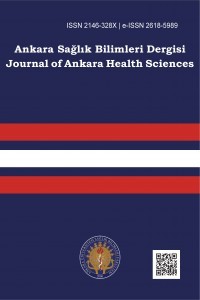Üniversite öğrencilerinde dismenore yaşama sıklığı ve etkileyen faktörlerin değerlendirilmesi
Bu çalışma üniversite öğrencileri arasında dismenore sıklığının saptanması, dismenoreyle ilişkili bazı faktörlerin incelenmesi ve baş etmeye yönelik yapılan uygulamaların belirlenmesi amacı ile tanımlayıcı olarak yürütülmüştür. ortalama, standart sapma, ki-kare ve lojistik regresyon analizleri kullanılmıştır. Çalışmada istatistiksel olarak anlamlılık değeri p<0.05 olarak kabul edilmiştir. Çalışmamızda öğrencilerin yaş ortalaması 19,83±1,43 (min:17, max:36) ve dismenore prevelansı %66,2 olarak belirlenmiş olup, aile öyküsünde dismonere olanlarda, sigara kullananlarda, menstruasyon sırasında kanama miktarı fazla olanlarda, menstruasyon öncesi şikayeti olanlarda, düzensiz menstruasyona sahip olanlarda dismenore görülme sıklığı daha yüksektir (p<0,05). Dismenore öyküsü olan öğrenciler en sık karın ağrısı (%53,4), bel ağrısı (%33,3) ve sinirlilik (%29,4) yaşamakta olup, baş etmeye yönelik yaptığı uygulamalar arasında ayaklara sıcak uygulama, dinlenme-uyuma ve analjezik alma yer almaktadır. Sonuç olarak, dismenore kızlar arasında yaygın olarak görülen önemli bir halk sağlığı sorunu olup, yaşam kalitesinin düşmesine neden olmaktadır. Bu bakımdan hemşireler tarafından okullarda dismenore yaşayan öğrencilerin bu sorunları ile başa çıkmasına yardım edecek eğitimler düzenlenmeli ve kızlara olumlu sağlık davranışı kazandırılmalıdır
EVALUATION OF THE FREQUENCY OF DYSMENORRHEA AND ASSOCIATED FACTORS AMONG THE UNIVERSITY STUDENTS
This descriptive study was conducted to determine the frequency of dysmenorrhea, to review some associated factors and to identify the methods for coping with the dysmenorrhea among the students. The study was conducted from 01 December 2013 to 30 January 2014 on a total of 503 female students educated at Ankara Yildirim Beyazit University and agreed to take part in the study. Personal Information Form was used to collect data in the study. The Personal Information Form which was prepared by the investigators by reviewing the literature in line with the objective of the study was completed by the students under supervision within 15 to 20 minutes. The data were evaluated with the statistical program in computer; number, percentage, mean, standard deviation, chi-square and logistic regression analyses were used in the statistical analyses. Statistical significance value was accepted as p<0.05 in the study. In our study, the mean age of the students were 19.83±1.43 (min:17, max:36) and prevalence of the dysmenorrhea was determined to be 66.2%. The frequency of dysmenorrhea was higher in the smokers, those with a family history of dysmenorrhea, those with heavy menstrual bleeding, those with pre-menstrual complaints and those with irregular menstruation (p<0.05).The students with a history of dysmenorrhea most frequently suffered from abdominal pain (53.4%), low back pain (33.3%) and nervousness (29.4%) and the methods for coping with dysmenorrhea included applying heat to the feet, resting, sleeping and analgesics. Consequently, dysmenorrhea is an important public health issue which is common among women and causes a reduction in quality of life. The nurses should therefore provide trainings for coping semptoms of dysmenorrhea and resolving the problems in schools and the health behavior of the women should be influenced positively
